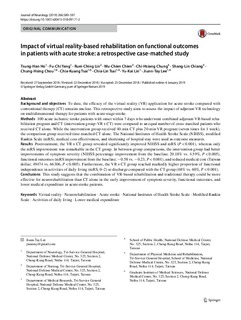Impact of virtual reality-based rehabilitation on functional outcomes in patients with acute stroke: a retrospective case-matched study
Ho, Tsung-Han; Yang, Fu-Chi; Lin, Ruei-Ching; Chien, Wu-Chien; Chung, Chi-Hsiang; Chiang, Shang-Lin; Chou, Chung-Hsing; Tsai, Chia-Kuang; Tsai, Chia-Lin; Lin, Yu-Kai; Lee, Jiunn-Tay
Journal article

Åpne
Permanent lenke
http://hdl.handle.net/11250/2602155Utgivelsesdato
2019Metadata
Vis full innførselOriginalversjon
Ho, T.-H., Yang, F.-C., Lin, R.-C., Chien, W.-C., Chung, C.-H., Chiang, S.-L., . . . Lee, J.-T. (2019). Impact of virtual reality-based rehabilitation on functional outcomes in patients with acute stroke: a retrospective case-matched study. Journal of Neurology, 266(3), 589-597. https://doi.org/10.1007/s00415-018-09171-2Sammendrag
Background and objectives
To date, the efficacy of the virtual reality (VR) application for acute stroke compared with conventional therapy (CT) remains unclear. This retrospective study aims to assess the impact of adjuvant VR technology on multidimensional therapy for patients with acute-stage stroke.
Methods
100 acute ischemic stroke patients with onset within 7 days who underwent combined adjuvant VR-based rehabilitation program and CT (intervention group–VR + CT) were compared to an equal number of cross-matched patients who received CT alone. While the intervention group received 40-min CT plus 20-min VR program (seven times for 1 week), the comparison group received time-matched CT alone. The National Institutes of Health Stroke Scale (NIHSS), modified Rankin Scale (mRS), medical cost-effectiveness, and shortening of hospital stay were used as outcome measures.
Results
Posttreatment, the VR + CT group revealed significantly improved NIHSS and mRS (P < 0.001), whereas only the mRS improvement was remarkable in the CT group. In between-group comparisons, the intervention group had better improvements of symptom severity (NIHSS percentage improvement from the baseline; 20.18% vs. 4.59%, P < 0.005), functional outcomes (mRS improvement from the baseline; − 0.58 vs. − 0.23, P < 0.001), and reduced medical cost (Taiwan dollar; 49474 vs. 66306, P < 0.005). Furthermore, the VR + CT group reached markedly higher proportion of functional independence in activities of daily living (mRS, 0–2) at discharge compared with the CT group (68% vs. 60%, P < 0.001).
Conclusions
This study suggests that the combination of VR-based rehabilitation and traditional therapy could be more effective for neurorehabilitation than CT alone in the early improvement of symptom severity, functional outcomes, and lower medical expenditure in acute stroke patients.